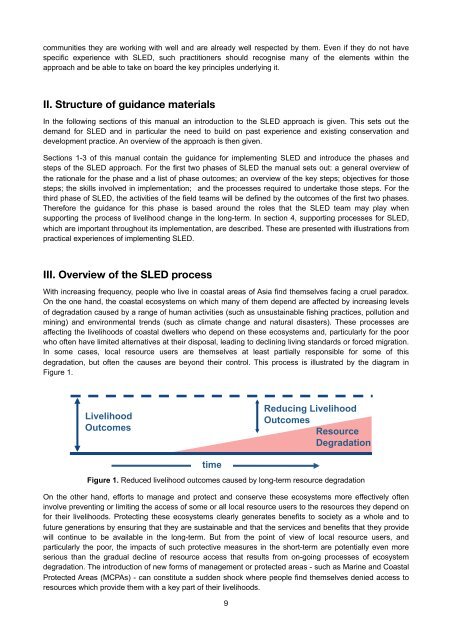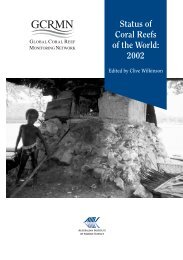Sustainable Livelihoods Enhancement and Diversification (SLED)
Sustainable Livelihoods Enhancement and Diversification (SLED)
Sustainable Livelihoods Enhancement and Diversification (SLED)
Create successful ePaper yourself
Turn your PDF publications into a flip-book with our unique Google optimized e-Paper software.
communities they are working with well <strong>and</strong> are already well respected by them. Even if they do not have<br />
specific experience with <strong>SLED</strong>, such practitioners should recognise many of the elements within the<br />
approach <strong>and</strong> be able to take on board the key principles underlying it.<br />
II. Structure of guidance materials<br />
In the following sections of this manual an introduction to the <strong>SLED</strong> approach is given. This sets out the<br />
dem<strong>and</strong> for <strong>SLED</strong> <strong>and</strong> in particular the need to build on past experience <strong>and</strong> existing conservation <strong>and</strong><br />
development practice. An overview of the approach is then given.<br />
Sections 1-3 of this manual contain the guidance for implementing <strong>SLED</strong> <strong>and</strong> introduce the phases <strong>and</strong><br />
steps of the <strong>SLED</strong> approach. For the first two phases of <strong>SLED</strong> the manual sets out: a general overview of<br />
the rationale for the phase <strong>and</strong> a list of phase outcomes; an overview of the key steps; objectives for those<br />
steps; the skills involved in implementation; <strong>and</strong> the processes required to undertake those steps. For the<br />
third phase of <strong>SLED</strong>, the activities of the field teams will be defined by the outcomes of the first two phases.<br />
Therefore the guidance for this phase is based around the roles that the <strong>SLED</strong> team may play when<br />
supporting the process of livelihood change in the long-term. In section 4, supporting processes for <strong>SLED</strong>,<br />
which are important throughout its implementation, are described. These are presented with illustrations from<br />
practical experiences of implementing <strong>SLED</strong>.<br />
III. Overview of the <strong>SLED</strong> process<br />
With increasing frequency, people who live in coastal areas of Asia find themselves facing a cruel paradox.<br />
On the one h<strong>and</strong>, the coastal ecosystems on which many of them depend are affected by increasing levels<br />
of degradation caused by a range of human activities (such as unsustainable fishing practices, pollution <strong>and</strong><br />
mining) <strong>and</strong> environmental trends (such as climate change <strong>and</strong> natural disasters). These processes are<br />
affecting the livelihoods of coastal dwellers who depend on these ecosystems <strong>and</strong>, particularly for the poor<br />
who often have limited alternatives at their disposal, leading to declining living st<strong>and</strong>ards or forced migration.<br />
In some cases, local resource users are themselves at least partially responsible for some of this<br />
degradation, but often the causes are beyond their control. This process is illustrated by the diagram in<br />
Figure 1.<br />
Livelihood<br />
Outcomes<br />
Reducing Livelihood<br />
Outcomes<br />
Resource<br />
Degradation<br />
time<br />
Figure 1. Reduced livelihood outcomes caused by long-term resource degradation<br />
On the other h<strong>and</strong>, efforts to manage <strong>and</strong> protect <strong>and</strong> conserve these ecosystems more effectively often<br />
involve preventing or limiting the access of some or all local resource users to the resources they depend on<br />
for their livelihoods. Protecting these ecosystems clearly generates benefits to society as a whole <strong>and</strong> to<br />
future generations by ensuring that they are sustainable <strong>and</strong> that the services <strong>and</strong> benefits that they provide<br />
will continue to be available in the long-term. But from the point of view of local resource users, <strong>and</strong><br />
particularly the poor, the impacts of such protective measures in the short-term are potentially even more<br />
serious than the gradual decline of resource access that results from on-going processes of ecosystem<br />
degradation. The introduction of new forms of management or protected areas - such as Marine <strong>and</strong> Coastal<br />
Protected Areas (MCPAs) - can constitute a sudden shock where people find themselves denied access to<br />
resources which provide them with a key part of their livelihoods.<br />
9
















